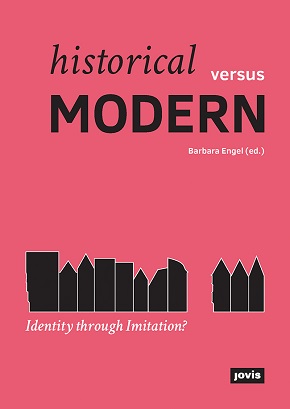Historical versus Modern: identity through imitation
Historical versus Modern: identity through imitation, Barbara Engel (editor) with Johannes Blechschmidt, Max Mutsch and Philine Schneider, Jovis Verlag GmbH. 2018, 213 pages, many urban plans and colour illustrations.
In an age of rapid urban growth, the longing for stability and rootedness has often fostered a return to historical forms and local identities. Across the world, city districts are being historicised during the process of reconstruction. This German (English language) publication examines a number of international projects exemplifying the trend. The authors’ aim is to understand the motivations behind them and whether they provide models of good urban design. The 14 selected examples vary widely, from reconstruction after loss with the aim of recovering their history, to new ‘Old Cities’ that provide an invented past. There are also copied places where imitation becomes an urban development principle in order to create a tourist magnet.
The book is edited by Barbara Engel, who has followed the contested discussions on this topic over several years. In most instances she has found that public opinion, which predominantly supports historicising new constructions, is diametrically opposed by conservation professionals, urban planners and architects. This makes it a difficult subject and the book skilfully avoids taking an unduly partisan approach. Yet there is a sense that collective memory is a powerful driver for recovering history. The book raises many interesting lines of enquiry, for example, can lost identities be retrieved with reconstructed buildings, and is the multi-faceted nature of urban history accurately reflected in present-day recreations?
The book is divided into four sections, each featuring between two and five urban development plans. The first is Reconstruction after Loss, which includes the Polish city of Elbing, which was largely destroyed in 1945 and rebuilt in a contemporary interpretation of its original historic form. This makes for a townscape that recalls the original merchant town, but it is criticised by many local historians and architects as a vision of what an old town might look like rather than the reality of the one that was destroyed. A more polarised debate has taken place between traditionalists and modernists over the Dom-Römer area of Frankfurt. This resulted in a mix of both historical reconstructions and contemporary designs, but with little thought given to their harmonisation.
Section 2, titled Copied Spaces, considers China’s practice of imitating western European landmarks and districts. Two new satellite towns in Shanghai are featured. Anting is intended to represent a modern ecologically-based model of a German city, while Thames Town imitates British small-town typology, with Stratford-on-Avon used as the template. Next comes New Old Cities, a concept involving construction of an imagined past, with the aim of fostering neighbourliness, social cohesion and sense of place. The prime example is Poundbury, but more remarkable is the postmodern historicism displayed at the new town of Haverleij in the Netherlands, and a brave attempt to challenge the American love of the suburbs at the Mercado District in Tucson, Arizona.
The final section examines Transformations of History, which see cities not as static constructs but as places subject to constant change. An example is Skopje 2014, a state-sponsored regeneration project focused on the urban core of the capital city of the Republic of Macedonia, which aims to project a new interpretation of national history. Populist in nature, this involves renovating existing buildings, façade-cladding buildings of the Socialist era, and creating monuments, sculptures and even a triumphal arch.
Although the examples chosen to illustrate these international approaches to ‘heritage-based’ regeneration are difficult to compare, given the lack of consistency in planning regimes, politics and cultural values, the book raises many pertinent questions about the methods that are being used, their capacity for strengthening local identity and their lasting value.
This article originally appeared as ‘Recovering history’ in IHBC's Context 159 (Page 63), published in May 2019. It was written by Peter de Figueiredo, heritage consultant.
--Institute of Historic Building Conservation
Related articles on Designing Buildings Wiki
- Architectural styles.
- British post war mass housing.
- Conservation.
- Demolishing Modernism: Britain's lost post-war gems.
- Eclecticism.
- Historic England.
- IHBC articles.
- Mimetic architecture.
- Post-modernism.
- The Inquiry - Mansion House Square v. Number 1 Poultry.
- The Institute of Historic Building Conservation.
- Vernacular architecture.
IHBC NewsBlog
Old Sarum fire in listed (& disputed) WW1 Hangar - Wiltshire Council has sought legal advice after fire engulfed a listed First World War hangar that was embroiled in a lengthy planning dispute.
UK Antarctic Heritage Trust launches ‘Virtual Visit’ website area
The Trust calls on people to 'Immerse yourself in our heritage – Making Antarctica Accessible'
Southend Council pledge to force Kursaal owners to maintain building
The Council has pledged to use ‘every tool in the toolbox’ if urgent repairs are not carried out.
HE’s Research Magazine publishes a major study of the heritage of England’s suburbs
The article traces the long evolution of an internal programme to research 200 years of suburban growth
IHBC Context 183 Wellbeing and Heritage published
The issue explores issues at the intersection of heritage and wellbeing.
SAVE celebrates 50 years of campaigning 1975-2025
SAVE Britain’s Heritage has announced events across the country to celebrate bringing new life to remarkable buildings.
IHBC Annual School 2025 - Shrewsbury 12-14 June
Themed Heritage in Context – Value: Plan: Change, join in-person or online.
200th Anniversary Celebration of the Modern Railway Planned
The Stockton & Darlington Railway opened on September 27, 1825.
Competence Framework Launched for Sustainability in the Built Environment
The Construction Industry Council (CIC) and the Edge have jointly published the framework.
Historic England Launches Wellbeing Strategy for Heritage
Whether through visiting, volunteering, learning or creative practice, engaging with heritage can strengthen confidence, resilience, hope and social connections.















